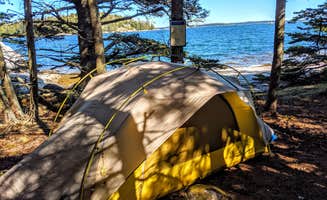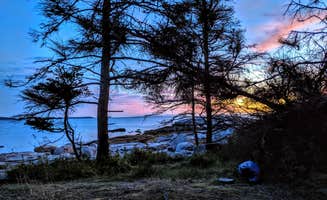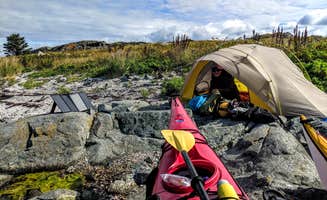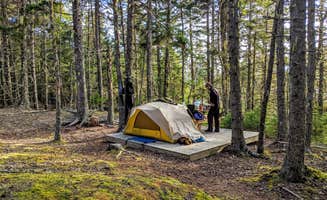The Maine Island Trail Association (MITA) maintains several primitive boat-in campsites on islands off the coast of Maine, accessible from the Searsmont region. These dispersed camping locations require sea kayaking skills and proper tide timing. Most of these islands feature rocky granite shorelines with limited sandy areas for landing watercraft. Weather conditions can change rapidly, making advance planning essential for safe island access.
What to do
Paddle exploration routes: The area around Buckle Island offers multiple day-trip options for sea kayakers seeking rustic camping near Searsmont, Maine. "One of the MITA camping areas in the Deer Isle Archipelago, this island has 2 sites – one larger area up in the woods, the other quite small near the granite shore, but both accessible from the east side of the island," notes one camper.
Sunset photography: Western-facing campsites on Wheat Island provide optimal conditions for sunset photography over the Gulf of Maine. According to a visitor, the larger site on the southwest side offers "a gorgeous view of the sun setting and full moon rising." Clear nights reveal extensive star fields over the open water.
Beach fires: Build evening fires on sand beaches where permitted. On Sand Cove at Marshall Island, campers can legally have beach fires away from vegetation. These sites remain popular for overnight kayak camping trips throughout summer and early fall months.
What campers like
Easy landings: First-time sea kayak campers appreciate specific locations with manageable shorelines. "This is a perfect island for those new to sea kayak camping as the sandy shore, which is exposed for a good portion of the day, is easy to land on and a short walk to a trail into the woods," reports one Buckle Island camper.
Strategic positioning: Doliver Island serves as a tactical stopping point for multi-day expeditions. One paddler explains it provides "a perfect launching spot for crossing Jericho Bay (4.5 miles) to Marshall Island the next day." The island features a "gorgeous shell covered beach and a beautiful view of Isle au Haut, just next door."
Night skies: The minimal light pollution around these offshore islands creates ideal conditions for astronomical observation. The open horizon provides unobstructed views across the water. Many visitors bring red-light headlamps to preserve night vision while moving around camp after dark.
What you should know
Site limitations: Some islands have extremely restricted camping capacity. A camper describes Doliver Island as "small with barely a tent space," noting it has room for "just 1 tent...barely!" Always have backup destinations planned in case primary sites are occupied.
Insect preparation: Mosquito activity remains high through early autumn on most islands. A Marshall Island visitor noted: "Despite the fact that the other islands had pesky mosquitoes, this site had none." Pack appropriate repellent, netting, and clothing for evening insect protection.
Tide timing: Landing conditions vary significantly between high and low tide. A Wheat Island visitor warns: "This can be a tricky island to land on at high tide, so plan accordingly." Consult marine tide charts and time arrivals/departures for optimal water levels, especially for islands with steep rocky approaches.
Tips for camping with families
First-timer islands: Families new to sea kayaking should target specific islands with easier access. Buckle Island provides "a sandy shore, which is exposed for a good portion of the day," making it safer for children and less experienced paddlers during landing and launching.
Amenities selection: Choose Marshall Island for its minimal comforts. A visitor describes the Sand Cove area as "a truly gorgeous wooded area with a tent platform and a picnic table at each site," providing slightly more infrastructure than other primitive islands.
Supply planning: Calculate water needs carefully as no freshwater sources exist on these islands. One experienced camper notes: "If you happen to need a food or water resupply, Swan's Island is a short paddle away and has a very small grocery store and town office with fresh water." Family groups typically require 1-2 gallons per person per day.
Tips from RVers
Base camp options: Use mainland campgrounds as staging areas for day trips to islands. Several commercial campgrounds within 30 minutes of boat launches provide secure parking for vehicles and trailers while paddling to islands.
Boat storage: No RV facilities exist on the MITA islands themselves. When planning multi-day boat-in camping from an RV base, secure kayaks properly during transit. Most mainland launch points have limited overnight parking available for RVs.
Seasonal considerations: RV travelers seeking primitive camping experiences near Searsmont should note island camping conditions deteriorate rapidly after mid-October. Strong winds, cold water temperatures, and reduced daylight hours create challenging paddling conditions unsuitable for all but the most experienced sea kayakers.





